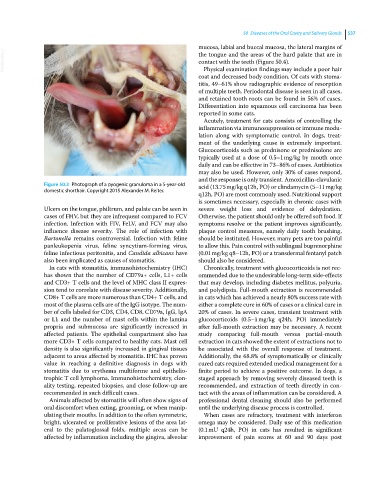Page 569 - Clinical Small Animal Internal Medicine
P. 569
50 Diseases of the Oral Cavity and Salivary Glands 537
mucosa, labial and buccal mucosa, the lateral margins of
VetBooks.ir the tongue and the areas of the hard palate that are in
contact with the teeth (Figure 50.4).
Physical examination findings may include a poor hair
coat and decreased body condition. Of cats with stoma
titis, 49–61% show radiographic evidence of resorption
of multiple teeth. Periodontal disease is seen in all cases,
and retained tooth roots can be found in 56% of cases.
Differentiation into squamous cell carcinoma has been
reported in some cats.
Acutely, treatment for cats consists of controlling the
inflammation via immunosuppression or immune modu
lation along with symptomatic control. In dogs, treat
ment of the underlying cause is extremely important.
Glucocorticoids such as prednisone or prednisolone are
typically used at a dose of 0.5–1 mg/kg by mouth once
daily and can be effective in 73–86% of cases. Antibiotics
may also be used. However, only 30% of cases respond,
and the response is only transient. Amoxicillin‐clavulanic
Figure 50.3 Photograph of a pyogenic granuloma in a 5‐year‐old acid (13.75 mg/kg q12h, PO) or clindamycin (5–11 mg/kg
domestic shorthair. Copyright 2015 Alexander M. Reiter.
q12h, PO) are most commonly used. Nutritional support
is sometimes necessary, especially in chronic cases with
Ulcers on the tongue, philtrum, and palate can be seen in severe weight loss and evidence of dehydration.
cases of FHV, but they are infrequent compared to FCV Otherwise, the patient should only be offered soft food. If
infection. Infection with FIV, FeLV, and FCV may also symptoms resolve or the patient improves significantly,
influence disease severity. The role of infection with plaque control measures, namely daily tooth brushing,
Bartonella remains controversial. Infection with feline should be instituted. However, many pets are too painful
panleukopenia virus, feline syncytium‐forming virus, to allow this. Pain control with sublingual buprenorphine
feline infectious peritonitis, and Candida albicans have (0.01 mg/kg q8–12h, PO) or a transdermal fentanyl patch
also been implicated as causes of stomatitis. should also be considered.
In cats with stomatitis, immunohistochemistry (IHC) Chronically, treatment with glucocorticoids is not rec
has shown that the number of CD79a+ cells, L1+ cells ommended due to the undesirable long‐term side‐effects
and CD3+ T cells and the level of MHC class II expres that may develop, including diabetes mellitus, polyuria,
sion tend to correlate with disease severity. Additionally, and polydipsia. Full‐mouth extraction is recommended
CD8+ T cells are more numerous than CD4+ T cells, and in cats which has achieved a nearly 80% success rate with
most of the plasma cells are of the IgG isotype. The num either a complete cure in 60% of cases or a clinical cure in
ber of cells labeled for CD3, CD4, CD8, CD79a, IgG, IgA 20% of cases. In severe cases, transient treatment with
or L1 and the number of mast cells within the lamina glucocorticoids (0.5–1 mg/kg q24h, PO) immediately
propria and submucosa are significantly increased in after full‐mouth extraction may be necessary. A recent
affected patients. The epithelial compartment also has study comparing full‐mouth versus partial‐mouth
more CD3+ T cells compared to healthy cats. Mast cell extraction in cats showed the extent of extractions not to
density is also significantly increased in gingival tissues be associated with the overall response of treatment.
adjacent to areas affected by stomatitis. IHC has proven Additionally, the 68.8% of symptomatically or clinically
value in reaching a definitive diagnosis in dogs with cured cats required extended medical management for a
stomatitis due to erythema multiforme and epithelio finite period to achieve a positive outcome. In dogs, a
trophic T cell lymphoma. Immunohistochemistry, clon staged approach by removing severely diseased teeth is
ality testing, repeated biopsies, and close follow‐up are recommended, and extraction of teeth directly in con
recommended in such difficult cases. tact with the areas of inflammation can be considered. A
Animals affected by stomatitis will often show signs of professional dental cleaning should also be performed
oral discomfort when eating, grooming, or when manip until the underlying disease process is controlled.
ulating their mouths. In addition to the often symmetric, When cases are refractory, treatment with interferon
bright, ulcerated or proliferative lesions of the area lat omega may be considered. Daily use of this medication
eral to the palatoglossal folds, multiple areas can be (0.1 mU q24h, PO) in cats has resulted in significant
affected by inflammation including the gingiva, alveolar improvement of pain scores at 60 and 90 days post

